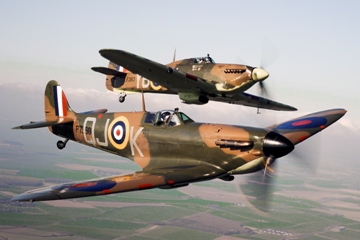
Spitfire and Hurricane (behind).
After France fell to Germany in June 1940 and the British Expeditionary Force had been evacuated from Dunkirk, Hitler had expected that Britain would negotiate a settlement with him. When Britain decided to fight on instead, Hitler ordered an invasion of England, code named Operation Sea Lion. If it was to succeed, Germany had to gain control of the air over the English Channel and the invasion beaches, so on August 15, 1940, the Luftwaffe (German air force) launched an all-out attack on the Royal Air Force (RAF), attacking its airfields, radar sites, headquarters, and the aircraft factories that supplied the RAF. The Luftwaffe came close to driving the RAF out of southeastern England. Unaware of this, and in need of a quick victory before the weather turned bad, on September 7 the Luftwaffe turned to bombing London, thinking that would force RAF fighters into a massive air battle that they would lose. The climax came on September 15, thereafter known as Battle of Britain Day, when Germany threw every plane it had into the air and suffered heavy losses. Two days later Operation Sea Lion was indefinitely postponed. About 2,500 RAF pilots fought the Battle of Britain, leading Winston Churchill to say, “Never in the field of human conflict was so much owed by so many to so few.” But, while fighter pilots were the cutting edge, it was the British people as a whole-steadfast in their defiance of Hitler-who provided the sword. It was, as Churchill also said, their finest hour.
#
In terms of aircraft, the German Messerschmitt Bf-109 and the British Supermarine Spitfire were quite evenly matched; the British Hurricane had a lower performance but was more maneuverable. Both RAF fighters benefited from the introduction of constant-speed propellers and 100- octane fuel during the battle. The Bf-110 was shown to be inferior to single-engined fighters, and the German Junkers Ju-87 Stuka dive-bomber was so vulnerable that it was withdrawn partway through the Battle of Britain. The RAF, however, had much to learn about fighter tactics. The Luftwaffe was using flexible, open formations that had worked well in Spain and earlier in the war. Many RAF squadrons were still using close formations that allowed little tactical flexibility.
#
There were several keys to the outcome. The RAF fighter force was larger than the Luftwaffe realized when the fight began, despite heavy losses over France and the Low Countries in May and June. Also, Britain was able to significantly out produce Germany in fighter aircraft throughout the campaign: Luftwaffe intelligence calculated a fighter replacement rate of 180-300 per month, whereas the RAF actually achieved a rate of nearly 500 per month. The Wehrmacht held back resources from German fighter production, which underachieved its goal by 40 percent in the summer of 1940. The RAF thus readily replaced its aircraft losses where the Luftwaffe did not. Similar erroneous estimates of RAF losses marked incompetent Luftwaffe intelligence reports throughout the battle. Also, the fight took place over Britain. That meant the RAF recovered many downed pilots but the Luftwaffe lost aircraft and crews: nearly 1,400 aircraft all told and many crews killed, taken prisoner, or lost in the Channel. British training schemes were already operating at full tilt, whereas the Luftwaffe’s were not. The RAF therefore did not have to draw down main reserves from the center and north of the country without also replacing those more idle squadrons with fresh aircraft and pilots. Fighter Command was further aided by a series of bad decisions born of sheer Nazi arrogance and the erratic decision-making system in Germany. The most fateful of these was Hitler’s choice-provoked by rage over two small British raids against Berlin-to switch bomber targeting from RAF airfields to attacks on British cities. That caused many civilian deaths but allowed the RAF to continue to attrit German bombers and fighters alike. The fundamental reason for the German defeat was the fact that the Luftwaffe was asked to improvise a strategic air campaign for which it did not have the right planes or doctrine, against sophisticated British air and ground defenses in preparation over several years. Finally, the Luftwaffe had no precedent, let alone direct experience, in attacking an enemy that waited behind a comprehensive early warning radar system and had an excellent command-and-control radio net with which to direct fighter air defenses.
When Luftwaffe losses became intolerable Hitler called off the air battle and invasion and turned instead to planning BARBAROSSA, the great attack on the Soviet Union by which he intended to deny Britain its last available continental ally and bring about its acceptance of terms. Hitler continued to harbor the delusion that Britain might agree to a separate peace, which he wanted for tactical reasons.
Along with the role played by “the few,” less well-acknowledged is the anti-invasion role played by the Royal Navy, which was the truly effective deterrent to Hitler. The Royal Navy was far superior to the Kriegsmarine in numbers of destroyers and capital warships. It is difficult to imagine an invasion fleet borne across the Channel-mainly on Rhine barges-surviving against the determined effort by the Royal Navy with which it surely would have met. That case was well-argued in 2006 by historians Brian James, Richard Overy, and Andrew Gordon of the Joint Service Command Staff College.
Suggested Reading: Richard Overy, The Battle of Britain: Myth and Reality (2000).